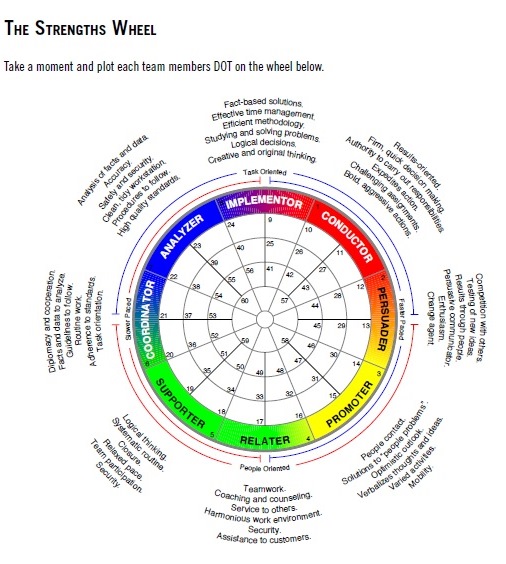The Strengths Wheel is a powerful visual tool that plots natural strengths and adaptive strengths. It is included in each Leading From Your Strengths profile report.
Your scores are plotted on the wheel as a means for you to identify, at a quick glance, your natural strengths and adaptive strengths.
The wheel is especially useful for teams or groups of people. When you plot individual team members’ scores on the wheel, you get a picture of how the team works together as an organism. This allows you and your group to identify areas of collective strength, gaps in functionality, and how the team is moving their strengths collectively to meet the demands of their environment.
These are questions teams ask most often about The Strengths Wheel.
FAQ #1: What are the wheel’s four main quadrants?
 The wheel is divided horizontally and vertically.
The wheel is divided horizontally and vertically.
The horizontal division (North-South) reveals orientation. Those people plotting in the North (upper) half are task-oriented. Their strength lies in “getting the job done.” Those on the South (lower) half are people-oriented. They do their best work when they interface with people.
The wheel’s vertical division (West-East) reveals pace. Those individuals plotting on the left (West) side of the wheel operate best at a slower pace. Those plotting on the right (East) operate best at a faster pace.
This information is valuable as you plot your team. Does the environment encourage accomplishing tasks or emphasizing interaction with people? You may also discover if (as a whole) your team works methodically and deliberately (slower-paced) or at a quick, ever-changing environment (fast-paced.) Your team’s strengths wheel may reveal why certain people or portions of the team flourish or struggle to fit into the overall team environment.
FAQ #2: What are the dots and the stars on the wheel?
Your dot on the wheel indicates your natural style. Your star on the wheel indicates your adapted style. When your dot and star are positioned closely together on the wheel, you are likely operating in an environment that is a good fit for your strengths. If your dot and star are farther apart on the wheel, you may be operating in an environment that requires you to expend considerable extra energy to be effective.
By plotting your team’s dots and stars together on a chart you can discover your team’s group strengths – what the team does best. Areas with few dots indicate team gaps in strengths. You will also discover, by looking at the stars, how your team is having to adapt.
FAQ #3: What do each of the 8 terms on the outside of the wheel mean?
The wheel is divided like a pie into 8 wedges. Each wedge represents a group of strengths, identified on the outer ring of the wheel with a descriptor term: Conductor, Persuader, Promoter, Relater, Supporter, Coordinator, Analyzer, and Implementer. Note that all descriptors are strengths. None are better than another, but rather each is useful and needed.
FAQ #4: What do the numbers on the wheel mean?
The wheel has concentric rings. Together the 8 descriptor wedges and the concentric rings divide the wheel into 60 sections. Each section is labeled with a number
The results of your profile report produce numeric scores (#1-60). Each respondent is classified with two scores: one for natural strengths (the dot) and one for adapted strengths (the star), which are plotted on the wheel.
Note the different sections in which each person’s dots and stars are plotted: outer two rings, center two rings, or in the innermost circle.
- Outer two rings (#1-24): identifiers placed here reveal a person’s strengths are strong (even rigid) and consistent, likely in a variety of environments.
- Center two rings (#25-56): identifiers place here reveal a person’s strengths are more flexible, allowing him to adapt with more ease.
- Center ring (#57-#60): these identifiers reveal cross patterns in a person’s strengths, representing conflicts. This individual may experience struggle in using all of his strengths concurrently.
FAQ #5: How can we use this information?
As you and your team plot results on a master Strengths Wheel, ask these three questions:
- What are our team’s strengths? You may find that a large number of team members’ natural strengths are clustered in a certain area, such as a people-oriented half of the wheel. This information shows you a collective strength of the group and can reveal why your team accomplishes certain processes easily.
- What are our team’s gaps? The absence of certain natural strengths on the wheel can reveal why your team struggles in that area. For instance, most of your group members operate best in a slower-paced environment, then you may come to understand why the team does not operate efficiently at a deadline time.
- Should we take any action based on what we’ve learned? Perhaps you and your team may decide to fill gaps in your team with your next hire, seeking out an individual with a different strengths set to round out your team. Or you may note that your team members make significant adapted strengths adjustments, which causes them to use a lot of energy. You may be able to alter the environment or expectations to allow members to use their strengths the best.
More about The Strengths Wheel
The Strengths Wheel: Videos #1 and #2
More FAQs
FAQs: How to Customize Your Communication With People Who Have Other Strengths
FAQs: Report Consolidation Template – Your Profile on One Page
FAQs: Tight Patterns and Neutral Graphs
